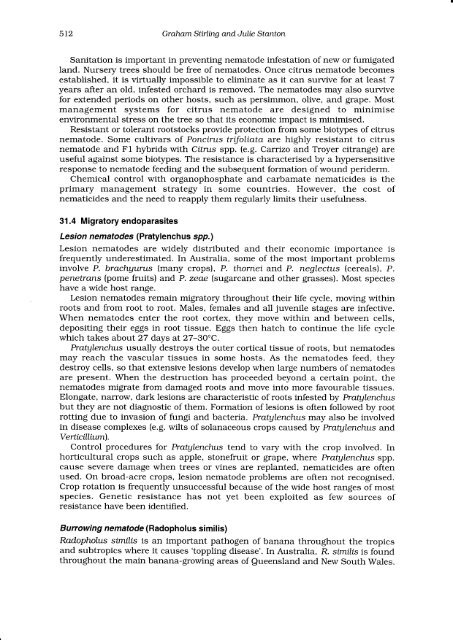NEMATODE DISEASES AND THEIR CONTROL Graham Stirling ...
NEMATODE DISEASES AND THEIR CONTROL Graham Stirling ...
NEMATODE DISEASES AND THEIR CONTROL Graham Stirling ...
Create successful ePaper yourself
Turn your PDF publications into a flip-book with our unique Google optimized e-Paper software.
512 <strong>Graham</strong> Sttrltng and Julie Stanton<br />
Sanitation is important in preventing nematode infestation of new or fumigated<br />
land. Nursery trees should be free of nematodes. Once citrus nematode becomes<br />
established, it is virtually impossible to eliminate as it can survive for at least 7<br />
years after an old, infested orchard is removed. The nematodes may also survive<br />
for extended periods on other hosts, such as persimmon, olive, and grape. Most<br />
management systems for citrus nematode are designed to minimise<br />
environmental stress on the tree so that its economic impact is minimised.<br />
Resistant or tolerant rootstocks provide protection from some biotypes of citrus<br />
nematode. Some cultivars of Poncirus trifoLtata are highly resistant to citrus<br />
nematode and Fl hybrids with Citrus spp. (e.g. Carrizo and Troyer citrange) are<br />
useful against some biotypes. The resistance is characterised by a hypersensitive<br />
response to nematode feeding and the subsequent formation of wound periderm.<br />
Chemical control with organophosphate and carbamate nematicides is the<br />
primary management strategy in some countries. However, the cost of<br />
nematicides and the need to reapply them regularly limits their usefulness.<br />
31.4 Migratory endoparasites<br />
Lesion nematodes (Pratylenchus spp. )<br />
Lesion nematodes are widely distributed and their economic importance is<br />
frequently underestimated. In Australia, some of the most important problems<br />
involve P. brachgurus (many crops), P. thornei and P. negLectus (cereals), P.<br />
penetrans (pome fruits) and P. zeae (su.garcane and other grasses). Most species<br />
have a wide host range.<br />
Lesion nematodes remain migratory throughout their life cycle, moving within<br />
roots and from root to root. Males, females and all juvenile stages are infective.<br />
When nematodes enter the root cortex, they move within and between cells,<br />
depositing their eggs in root tissue. Eggs then hatch to continue the life cycle<br />
which takes about 27 days at 27-3O"C.<br />
PratyLenchus usually destroys the outer cortical tissue of roots, but nematodes<br />
may reach the vascular tissues in some hosts. As the nematodes feed, they<br />
destroy cells, so that extensive lesions develop when large numbers of nematodes<br />
are present. When the destruction has proceeded beyond a certain point, the<br />
nematodes migrate from damaged roots and move into more favourable tissues.<br />
Elongate, n€urow, dark lesions are characteristic of roots infested by PratgLenchus<br />
but they are not diagnostic of them. Formation of lesions is often followed by root<br />
rotting due to invasion of fungi and bacteia. PratgLenchus may also be involved<br />
in disease complexes (e.g. wilts of solanaceous crops caused by Pratglenchus and<br />
VerticiLLtum).<br />
Control procedures for PratyLenchus tend to vary with the crop involved. In<br />
horticultural crops such as apple, stonefruit or grape, where PratgLenchus spp.<br />
cause severe damage when trees or vines are replanted, nematicides are often<br />
used. On broad-acre crops, lesion nematode problems are often not recognised.<br />
Crop rotation is frequently unsuccessful because of the wide host ranges of most<br />
species. Genetic resistance has not yet been exploited as few sources of<br />
resistance have been identified.<br />
B urrowi ng nematode (Radopholus similis)<br />
Radophotus similis is an important pathogen of banana throughout the tropics<br />
and subtropics where it causes 'toppling disease'. In Australia, R. similis is found<br />
throughout the main banana-growing areas of Queensland and New South Wales.






![[Compatibility Mode].pdf](https://img.yumpu.com/27318716/1/190x135/compatibility-modepdf.jpg?quality=85)










